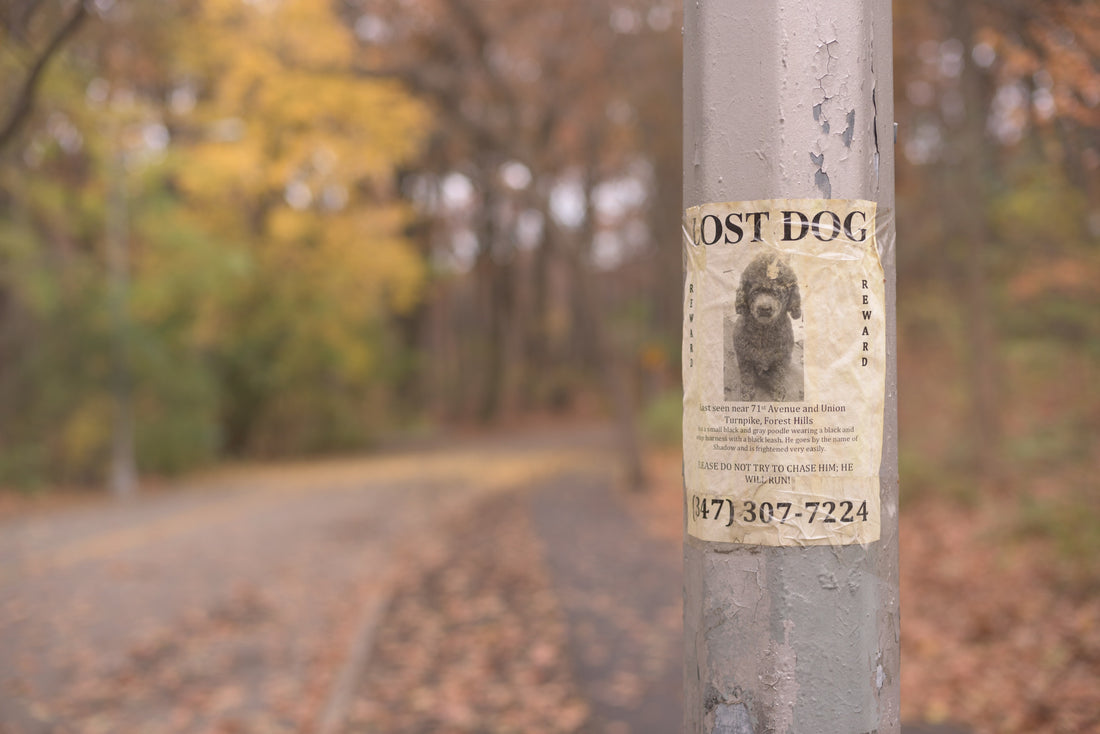According to American Humane, approximately 10 million pets go missing in the United States each year, and 1 out of every 3 pets will become lost at some point in their lifetime. Although millions end up in shelters, over 80% of unidentified lost pets are never reunited with their owners.
These are some pretty frightening statistics, but there are many things you can do to increase the odds of getting your pet back, as well as preventing them from going missing in the first place.
How To Prevent Your Dog from Going Missing
Identification
The most important step in keeping your dog safe is to make sure they are always wearing an ID tag. And if you have a busy household, this should include wearing ID even at home, because you never know when they might accidentally get out. An ID tag should have your dog’s name, your current phone number, and it should be easy to read. If your dog has any specific medical conditions you would want someone to know, i.e. “deaf”, “Needs Meds”, be sure to include this on their tag.

A second method of providing permanent identification is to have your dog chipped. A microchip can be read for free at any shelter or vet. One thing to remember is to register your chip and always keep it up to date.
Current Photos
Always have a current high-quality photo of your dog that can be used in the event they go missing. No one wants to think of this scenario, and for most pet parents, it’s their worst nightmare, but as the statistics clearly show, it happens too frequently. Hopefully, you will never need to use it, but the reality is, accidents happen, even to those of us who are vigilant about safety. A picture of your dog ready to be shared on social media and printed on flyers will save precious time.
Secure Yard and Home
To avoid accidental escape, make sure your house is secure. When outside, dogs should be in a fenced in yard, on a cable/tie out, or on a leash. And because some dogs slip their collars, using a halter when leash walking is a more secure option.
If you have an escape artist, or you do occasionally let your dog loose in the appropriate places, consider adding a GPS tracking device to their collar.
And as we head into the holiday season, a time when many dogs go missing, whether you are traveling or hosting guests, remember to be extra careful.
Steps to Take If Your Dog Goes Missing
First and foremost, take action immediately. This cannot be stated enough. Taking action right away will give you the best opportunity to recover your pet. As time passes, the likelihood of being reunited, quickly begins to diminish.

What To Do Right Away
- Get out and search on foot or in your car, depending on where you live.
- Knock on doors and enlist neighbors and friends to help you search the area.
- Stop cars and make them aware of your missing dog and give them your phone number.
What To Do Next
If an hour or two has passed, and you have not found your dog, it’s time to GET THE WORD OUT as quickly as possible:
- Notify the police and animal control.
- Get on social media and post everywhere you can. This is where that current photo of your dog will come in handy! If possible, have a friend post for you, so you can continue to search.
- Contact all animal shelter in your area and file a missing dog report.
- Join and list your missing dog with Lost Dogs of America. They are a network of Facebook pages across America that will share your listing with numerous missing pet groups in your state. They also provide valuable advice, and even help you create a missing pet flyer, all for FREE!
- Print “Lost Dog” flyers asap and hang them in high visibility areas within a radius of where your dog went missing. DIY flyers can easily be created with a computer and a home printer. Place the flyer in a gallon size ziplock storage bag and hang it upside down (to help keep it dry) using a staple gun, thumbtacks, or tape.
- Also hang flyers in public indoor places like the library, local stores, and the post office.
- Consider using a trap. Most shelters have traps they can loan you, or you can find an organization that will do it for you, and many offer their services for free. A hungry dog will often be lured into a trap with food.
- “Tag” your car! Using Neon Car Glass Markers, list your lost dog’s description and your phone number on your car’s rear window.

Photo credit: Missing Animal Response Network
Consider The Circumstance
Along with your dog’s personality, it’s also very important to take into consideration the circumstances surrounding your dog’s disappearance.
The approach towards searching for a dog who accidentally got out, or ran away out of fear during a traumatic event like a thunderstorm, fireworks, or a car accident, will be different than that of searching for a dog who dug a hole under their fence to get out and have a jaunt around the neighborhood.
A panicked dog will be much less inclined to make their way home or be agreeable to being caught by strangers than a dog who just has wanderlust.
Should You Offer a Reward For your Missing Dog?
If you are considering offering a reward for your pet, make sure you understand the pros and cons.
One of the most important things you need to know about offering a reward, is that it can be effective, but it totally depends on your dog’s personality.
For dogs that are very friendly and not at all skittish, offering a reward may be advisable, however, if your dog is unfamiliar with being around strangers, or is fearful, a reward can lead to people aggressively searching for your dog. We have all seen missing dog flyers that say, “Do Not Chase”. This is because with dogs that are nervous and skittish, being pursued by people will most likely have a negative impact on their rescue, scaring them into running further and hiding from people, even their own owners.
This behavior will even be exhibited by very friendly dogs, as they develop what is called, “Survival Mode”.

What is Survival Mode?
Once missing, a lost dog can go into “Survival Mode” within days, and even hours, despite having a loving home and caring owners. It’s very important to know, this is NOT your dog’s fault, and it is NOT your fault.
Survival Mode is a regression that naturally occurs when a dog has shifted to the primal instinct of just trying to survive. That means they are only concerned with finding food, water, and shelter. As most dogs who go missing are not used to finding these things on their own, you can imagine how stressful and detrimental this can be, especially when a dog is dehydrated, hungry, and scared.
This is also why chasing a dog, calling their name, and shaking treats can backfire, causing them to retreat further. Aside from trapping them, the best chance you have of retrieving them at this point is by sitting down near where you believe they are, being very quiet and calm, and allowing them to come to you. This requires patience and perseverance, but has been proven to be very successful.
Don’t Let Your Dog Become a Statistic

Appropriate safety measures can prevent your dog from going missing.
Taking action immediately will greatly increase the odds of being reunited with your dog.
Being prepared with a current photo and information about your dog will save time in the event that they go missing.
According to The Missing Animal Response Network, “Recovering a lost dog is all about launching a very visible marketing campaign.” Visit their website for TONS of helpful information about missing pets.




